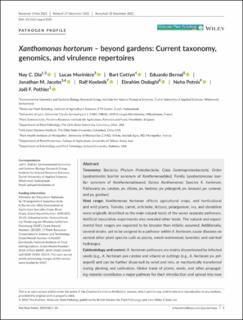Bitte benutzen Sie diese Kennung, um auf die Ressource zu verweisen:
https://doi.org/10.21256/zhaw-24016| Publikationstyp: | Beitrag in wissenschaftlicher Zeitschrift |
| Art der Begutachtung: | Peer review (Publikation) |
| Titel: | Xanthomonas hortorum – beyond gardens : current taxonomy, genomics, and virulence repertoires |
| Autor/-in: | Dia, Nay C. Morinière, Lucas Cottyn, Bart Bernal, Eduardo Jacobs, Jonathan M. Koebnik, Ralf Osdaghi, Ebrahim Potnis, Neha Pothier, Joël F. |
| et. al: | No |
| DOI: | 10.1111/mpp.13185 10.21256/zhaw-24016 |
| Erschienen in: | Molecular Plant Pathology |
| Band(Heft): | 23 |
| Heft: | 5 |
| Seite(n): | 597 |
| Seiten bis: | 621 |
| Erscheinungsdatum: | 23-Jan-2022 |
| Verlag / Hrsg. Institution: | Wiley |
| ISSN: | 1364-3703 1464-6722 |
| Sprache: | Englisch |
| Schlagwörter: | Bacterial blight; Carrot; Dandelion; Leaf spot; Lettuce; Pelargonium; Tomato; Xanthomonas hortorum |
| Fachgebiet (DDC): | 572: Biochemie 579: Mikrobiologie |
| Zusammenfassung: | Taxonomy: Bacteria; Phylum Proteobacteria; Class Gammaproteobacteria; Order Lysobacterales (earlier synonym of Xanthomonadales); Family Lysobacteraceae (earlier synonym of Xanthomonadaceae); Genus Xanthomonas; Species X. hortorum; Pathovars: pv. carotae, pv. vitians, pv. hederae, pv. pelargonii, pv. taraxaci, pv. cynarae, and pv. gardneri. Host range: Xanthomonas hortorum affects agricultural crops, and horticultural and wild plants. Tomato, carrot, artichoke, lettuce, pelargonium, ivy, and dandelion were originally described as the main natural hosts of the seven separate pathovars. Artificial inoculation experiments also revealed other hosts. The natural and experimental host ranges are expected to be broader than initially assumed. Additionally, several strains, yet to be assigned to a pathovar within X. hortorum, cause diseases on several other plant species such as peony, sweet wormwood, lavender, and oak-leaf hydrangea. Epidemiology and control: X. hortorum pathovars are mainly disseminated by infected seeds (e.g., X. hortorum pvs carotae and vitians) or cuttings (e.g., X. hortorum pv. pelargonii) and can be further dispersed by wind and rain, or mechanically transferred during planting and cultivation. Global trade of plants, seeds, and other propagating material constitutes a major pathway for their introduction and spread into new geographical areas. The propagules of some pathovars (e.g., X. horturum pv. pelargonii) are spread by insect vectors, while those of others can survive in crop residues and soils, and overwinter until the following growing season (e.g., X. hortorum pvs vitians and carotae). Control measures against X. hortorum pathovars are varied and include exclusion strategies (i.e., by using certification programmes and quarantine regulations) to multiple agricultural practices such as the application of phytosanitary products. Copper-based compounds against X. hortorum are used, but the emergence of copper-tolerant strains represents a major threat for their effective management. With the current lack of efficient chemical or biological disease management strategies, host resistance appears promising, but is not without challenges. The intrastrain genetic variability within the same pathovar poses a challenge for breeding cultivars with durable resistance. Useful websites: https://gd.eppo.int/taxon/XANTGA, https://gd.eppo.int/taxon/XANTCR, https://gd.eppo.int/taxon/XANTPE, https://www.euroxanth.eu, http://www.xanthomonas.org, http://www.xanthomonas.org/dokuwiki |
| URI: | https://digitalcollection.zhaw.ch/handle/11475/24016 |
| Volltext Version: | Publizierte Version |
| Lizenz (gemäss Verlagsvertrag): | CC BY 4.0: Namensnennung 4.0 International |
| Departement: | Life Sciences und Facility Management |
| Organisationseinheit: | Institut für Umwelt und Natürliche Ressourcen (IUNR) |
| Publiziert im Rahmen des ZHAW-Projekts: | Xhortomics: Entwicklung von diagnostischen und epidemiologischen Hilfsmitteln für die Xanthomonas hortorum Spezies Gruppe basierend auf OMICs Technologien |
| Enthalten in den Sammlungen: | Publikationen Life Sciences und Facility Management |
Dateien zu dieser Ressource:
| Datei | Beschreibung | Größe | Format | |
|---|---|---|---|---|
| 2022_Dia-etal_Xanthomonas-hortorum-taxonomy-genomics.pdf | 1.63 MB | Adobe PDF |  Öffnen/Anzeigen |
Zur Langanzeige
Dia, N. C., Morinière, L., Cottyn, B., Bernal, E., Jacobs, Jonathan M., Koebnik, R., Osdaghi, E., Potnis, N., & Pothier, J. F. (2022). Xanthomonas hortorum – beyond gardens : current taxonomy, genomics, and virulence repertoires. Molecular Plant Pathology, 23(5), 597–621. https://doi.org/10.1111/mpp.13185
Dia, N.C. et al. (2022) ‘Xanthomonas hortorum – beyond gardens : current taxonomy, genomics, and virulence repertoires’, Molecular Plant Pathology, 23(5), pp. 597–621. Available at: https://doi.org/10.1111/mpp.13185.
N. C. Dia et al., “Xanthomonas hortorum – beyond gardens : current taxonomy, genomics, and virulence repertoires,” Molecular Plant Pathology, vol. 23, no. 5, pp. 597–621, Jan. 2022, doi: 10.1111/mpp.13185.
DIA, Nay C., Lucas MORINIÈRE, Bart COTTYN, Eduardo BERNAL, Jonathan M. JACOBS, Ralf KOEBNIK, Ebrahim OSDAGHI, Neha POTNIS und Joël F. POTHIER, 2022. Xanthomonas hortorum – beyond gardens : current taxonomy, genomics, and virulence repertoires. Molecular Plant Pathology. 23 Januar 2022. Bd. 23, Nr. 5, S. 597–621. DOI 10.1111/mpp.13185
Dia, Nay C., Lucas Morinière, Bart Cottyn, Eduardo Bernal, Jonathan M. Jacobs, Ralf Koebnik, Ebrahim Osdaghi, Neha Potnis, and Joël F. Pothier. 2022. “Xanthomonas Hortorum – beyond Gardens : Current Taxonomy, Genomics, and Virulence Repertoires.” Molecular Plant Pathology 23 (5): 597–621. https://doi.org/10.1111/mpp.13185.
Dia, Nay C., et al. “Xanthomonas Hortorum – beyond Gardens : Current Taxonomy, Genomics, and Virulence Repertoires.” Molecular Plant Pathology, vol. 23, no. 5, Jan. 2022, pp. 597–621, https://doi.org/10.1111/mpp.13185.
Alle Ressourcen in diesem Repository sind urheberrechtlich geschützt, soweit nicht anderweitig angezeigt.